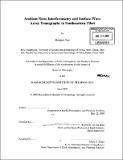| dc.contributor.advisor | Robert D. van der Hilst. | en_US |
| dc.contributor.author | Yao, Huajian | en_US |
| dc.contributor.other | Massachusetts Institute of Technology. Dept. of Earth, Atmospheric, and Planetary Sciences. | en_US |
| dc.coverage.spatial | a-cc-ti | en_US |
| dc.date.accessioned | 2010-03-25T15:03:04Z | |
| dc.date.available | 2010-03-25T15:03:04Z | |
| dc.date.copyright | 2009 | en_US |
| dc.date.issued | 2009 | en_US |
| dc.identifier.uri | http://hdl.handle.net/1721.1/53115 | |
| dc.description | Thesis (Ph. D.)--Massachusetts Institute of Technology, Dept. of Earth, Atmospheric, and Planetary Sciences, 2009. | en_US |
| dc.description | Includes bibliographical references. | en_US |
| dc.description.abstract | The primary goal of my doctoral research is to understand the crustal and upper mantle structure and deformation in southeastern Tibet. To improve the resolution in the crust, we developed a new approach for surface-wave array tomography by combining inter-station phase velocity dispersion measurements from empirical Green's functions (EGFs) recovered from ambient noise interferometry and from traditional teleseismic surface-wave two-station (TS) analysis. The non-stationarity (e.g., seasonal changes) and non-uniform distribution of ambient noise sources may obstruct full reconstruction of the surface-wave Green's functions, which may, in turn, degrade the accuracy of the tomographic models. Under the assumption of plane-wave propagation, we developed an iterative method to estimate ambient noise energy distribution, phase velocity bias primarily due to uneven noise energy distribution, and azimuthally anisotropic phase velocity maps. With phase velocity dispersion measurements at periods 10 - 150 s from 1 year data of 75 broad band stations in SE Tibet, we performed inversion for wavespeed variations and azimuthal anisotropy. The tomographic images revealed widespread crustal low-velocity zones (LVZs) at middle/lower crustal depth beneath SE Tibet. There is substantial lateral and vertical variability of these zones and some may be truncated by large faults. | en_US |
| dc.description.abstract | (cont.) The pattern of azimuthal anisotropy in the upper crust is consistent with clockwise rotation around the eastern Himalaya syntaxis and a predominance of simple shear and strike-slip faulting in SE Tibet. Comparison of splitting from SKS observations and from our 3D anisotropic model suggests that the contribution to splitting from the crust is at least as important as from the upper mantle in the region west of Sichuan Basin and north of 26°N. However, beneath Yunnan, splitting signal originates mainly from the upper mantle. The radial changes in deformation pattern argue against vertically coherent lithospheric deformation in Tibet. Combined with the widespread crustal LVZs, this supports models of ductile crustal flow beneath SE Tibet. However, the spatial variation in strength and depth of crustal LVZs and in pattern of azimuthal anisotropy suggests that the 3-D geometry of crustal weak layers is complex and that unhindered crustal flow over large regions may not occur. | en_US |
| dc.description.statementofresponsibility | by Huajian Yao. | en_US |
| dc.format.extent | 228 p. | en_US |
| dc.language.iso | eng | en_US |
| dc.publisher | Massachusetts Institute of Technology | en_US |
| dc.rights | M.I.T. theses are protected by
copyright. They may be viewed from this source for any purpose, but
reproduction or distribution in any format is prohibited without written
permission. See provided URL for inquiries about permission. | en_US |
| dc.rights.uri | http://dspace.mit.edu/handle/1721.1/7582 | en_US |
| dc.subject | Earth, Atmospheric, and Planetary Sciences. | en_US |
| dc.title | Ambient noise interferometry and surface-wave array tomography in southeastern Tibet | en_US |
| dc.type | Thesis | en_US |
| dc.description.degree | Ph.D. | en_US |
| dc.contributor.department | Massachusetts Institute of Technology. Department of Earth, Atmospheric, and Planetary Sciences | |
| dc.identifier.oclc | 503116035 | en_US |
